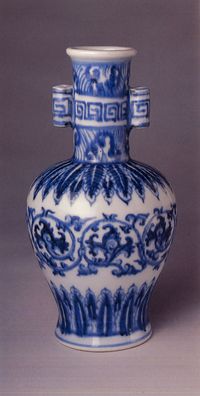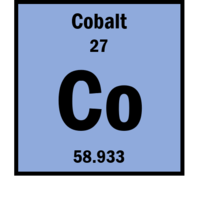Cobalt
Cobalt is the 27th element on the periodic table of elements, and is generally only found in the Earth's crust in compound form.[2] Some of its properties are listed below:[2]
| Atomic weight | 58.933 |
| Density (at 0oC) | 8.86 g/cm3 |
| Boiling point | 3200 K |
| Melting point | 1768 K |
Cobalt is a magnetic, silver-blue metal. It very rarely occurs in native form, so it is usually found as part of minerals (e.g. cobaltite and skutterudite) or with other elemental deposits (e.g. nickel and manganese).[2]
Cobalt Uses

Cobalt salts have long been used to create the distinctive blue colour for porcelain (Figure 2), as well as for enamel and paints, pottery, and glass.[2]
Pure cobalt metal is sometimes used for electroplating because it is hard and corrosion resistant. Cobalt is most commonly used as part of an alloy though. Cobalt alloys are used to make items that need high strength and corrosion resistance such as magnets, jet and gas turbine generators, surgical implants, and prosthetics.[2] Lithium cobalt oxide is one of the lithium oxides commonly used in rechargable lithium batteries.[4]
Radioactive cobalt-60 is a commonly used medical isotope. This isotope is used for radiotherapy, as a medical tracer, and to sterilize medical equipment through irradiation.[4]
Isotopes
Radioactive isotopes of cobalt tend to have very short half lives, most of which are less than 24 hours. Cobalt has only one isotope found in nature:[2]
| Symbol | Natural Abundance |
|---|---|
| 59Co | 100% |
Video
The video below is from the University of Nottingham's periodic videos project.[5] They have created a complete suite of short videos on every element on the periodic table of elements.
For Further Reading
- Periodic table of elements
- Metal
- Battery
- Magnet
- Or explore a random page
References
- ↑ Made internally by a member of the Energy Education team, with information from periodictable.com, Available: http://periodictable.com/Elements/001/index.html
- ↑ 2.0 2.1 2.2 2.3 2.4 2.5 Royal Society of Chemistry Periodic Table, Cobalt [Online], Available: http://www.rsc.org/periodic-table/element/27/cobalt
- ↑ Wikimedia Commons, "Ming dynasty Xuande mark and period (1426–35) imperial blue and white vase, from The Metropolitan Museum of Art." Accessed Oct. 20, 2018. Available: https://commons.wikimedia.org/wiki/File:Ming_dynasty_Xuande_mark_and_period_(1426%E2%80%9335)_imperial_blue_and_white_vase,_from_The_Metropolitan_Museum_of_Art._%E6%98%8E%E5%AE%A3%E5%BE%B7_%E6%99%AF%E5%BE%B7%E9%8E%AE%E7%AA%AF%E9%9D%92%E8%8A%B1%E8%B2%AB%E8%80%B3%E7%93%B6,_%E7%BA%BD%E7%BA%A6%E5%A4%A7%E9%83%BD%E5%8D%9A%E7%89%A9%E9%A6%86_.jpg
- ↑ 4.0 4.1 Cobalt Institute, Core Applications [Online], Available: https://www.cobaltinstitute.org/core-applications.html
- ↑ See more videos from the University of Nottingham on different elements here: http://www.periodicvideos.com/


